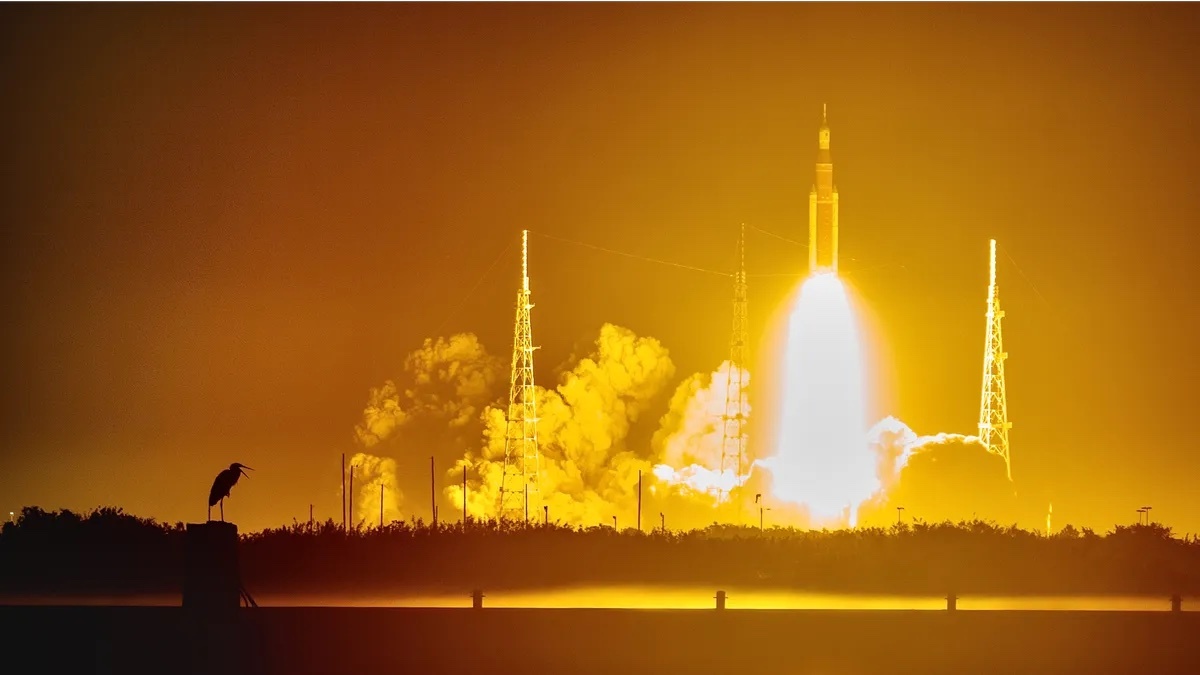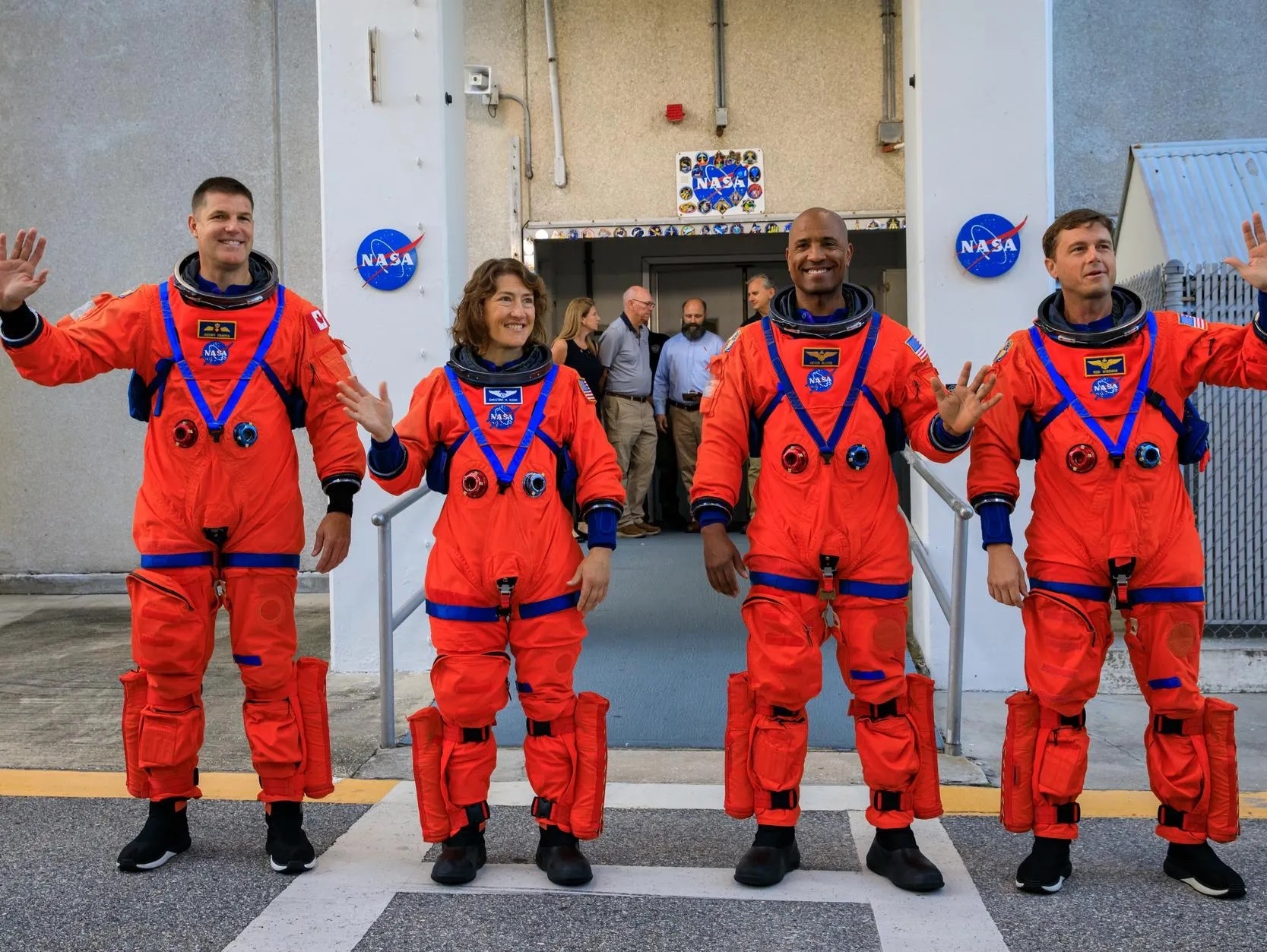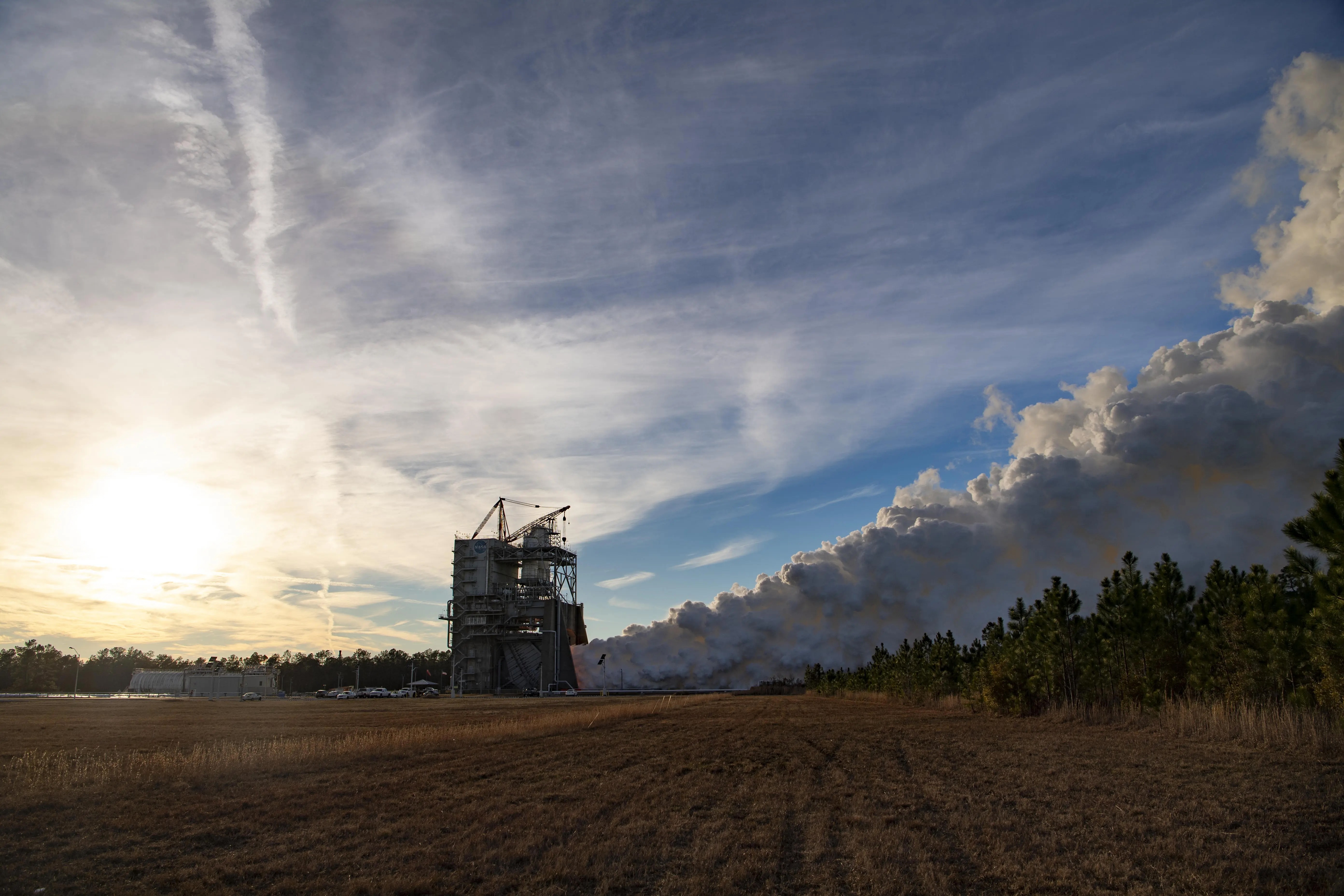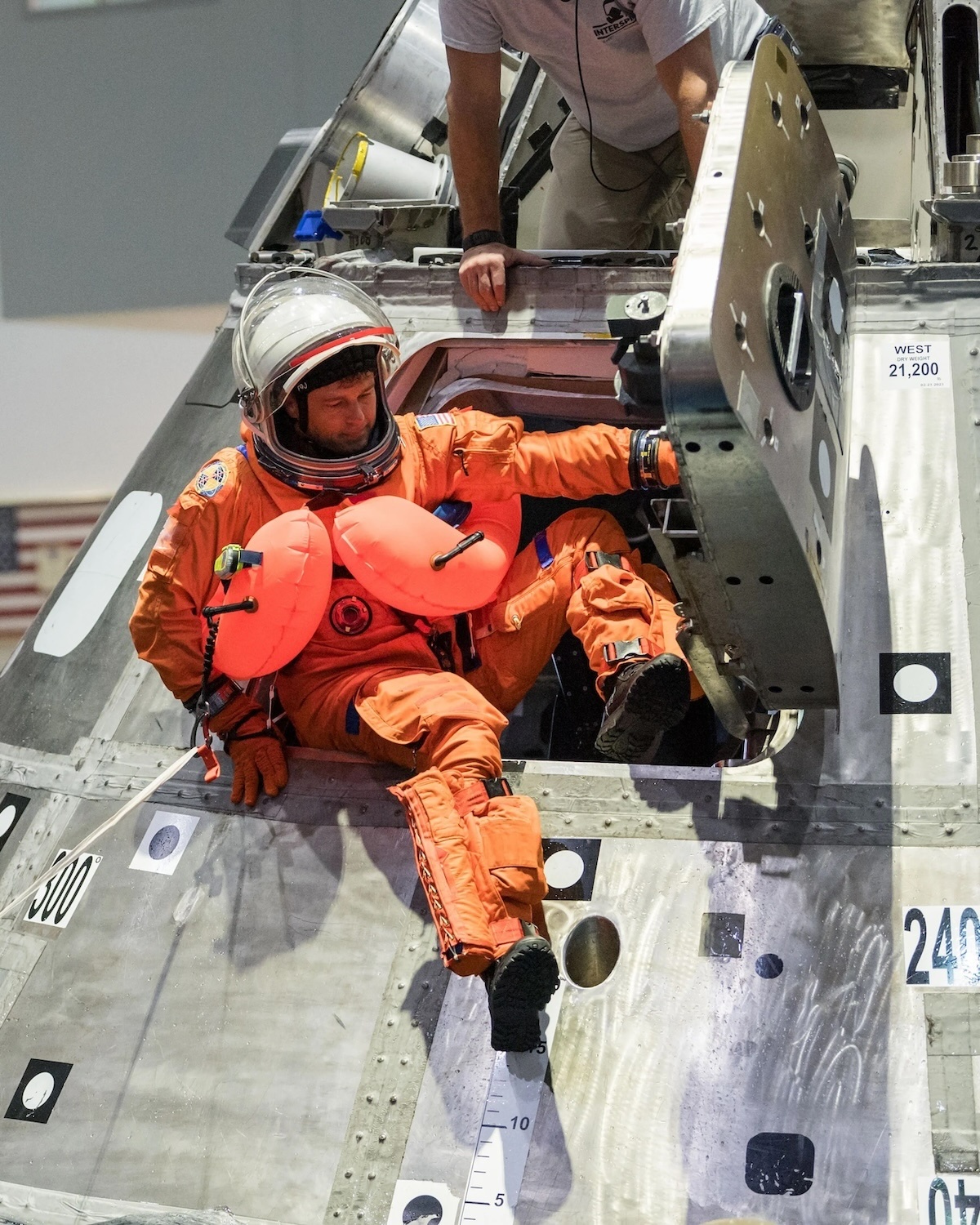21.10.2023
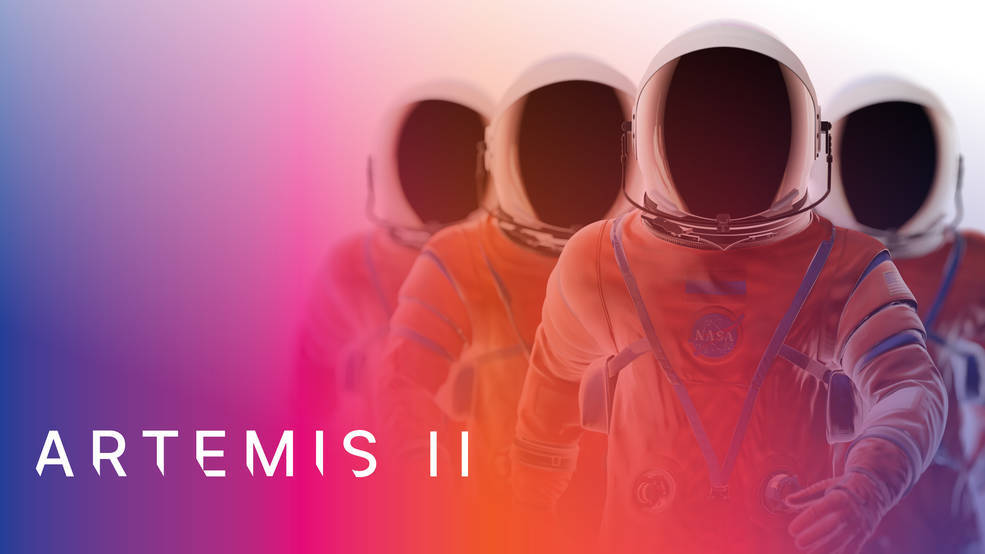
First Artemis Crew Trains for Mission Around Moon
Four astronauts are busy training for Artemis II, the first mission to carry humans on NASA’s powerful SLS (Space Launch System) rocket and Orion spacecraft, testing systems to support life in deep space on future Moon missions and expanding the space frontier beyond Earth orbit.
In August, the crew – NASA astronauts Reid Wiseman, Victor Glover, and Christina Koch, and CSA (Canadian Space Agency) astronaut Jeremy Hansen – finished the first part of their training known as fundamentals, establishing a foundational knowledge of all SLS and Orion systems.
The quartet began the process of learning every inch of their Orion crew module’s interior, which will serve as their home for the approximately 10-day flight test. They reviewed the building blocks for navigating the spacecraft’s displays and executing the procedures they will use to fly and monitor Orion. While some training activities included all four crew members together, other activities involved one-on-one sessions with trainers.
“The crew is making incredible progress getting ready for their flight as the first people to fly inside NASA’s newest spacecraft built for deep space,” said Jacki Mahaffey, chief training officer for Artemis II, based at NASA’s Johnson Space Center in Houston. “Their training is preparing them to do everything from planned mission tasks and daily operations, to how to recognize and deal with unexpected situations.”
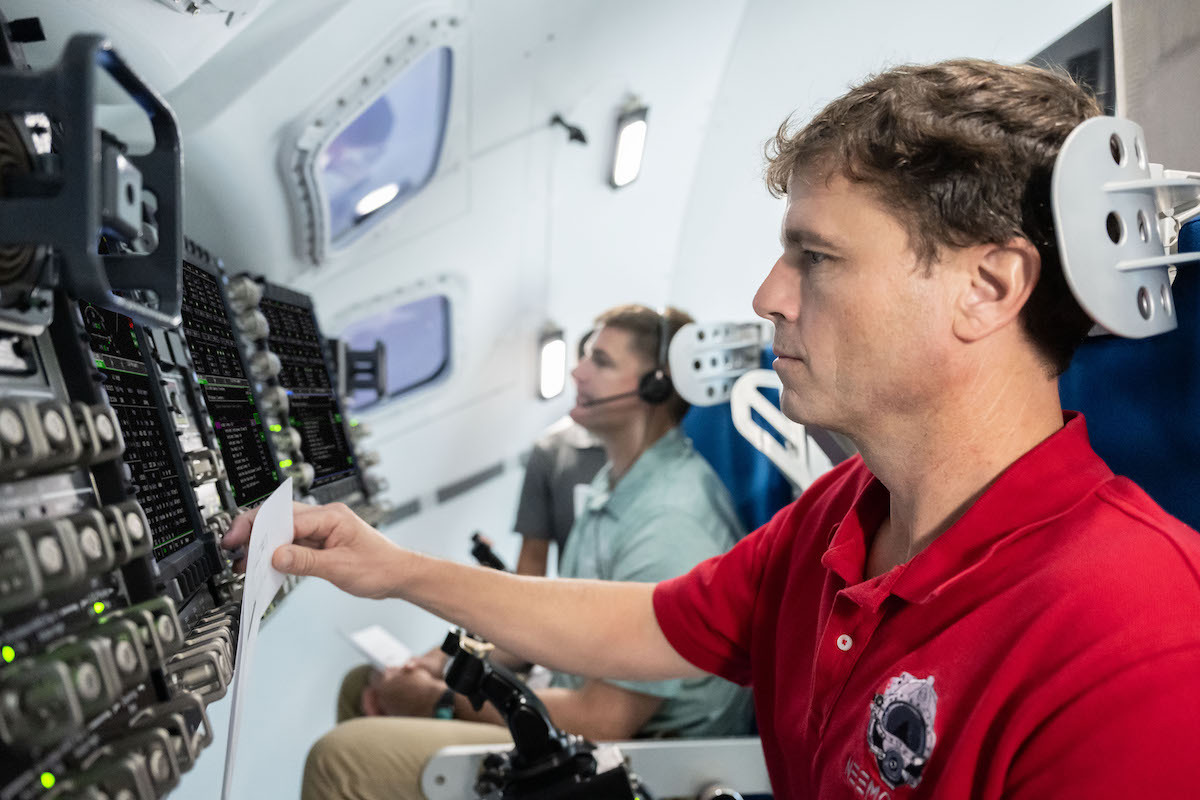
The full crew also took part in the first dry run for launch day operations at NASA’s Kennedy Space Center in Florida. The test gave the Exploration Ground Systems Program team an opportunity to share and demonstrate the steps involved in preparing the crew to get to their rocket and spacecraft on launch day, including donning their spacesuits, traveling to the launch pad, taking the elevator up the mobile launcher, and walking the crew access arm to the white room, where technicians will help them take their spacecraft seats and check out their systems atop the giant rocket.
“Our training has been very smooth so far and we have enjoyed meeting the men and women around the globe working to bring Artemis missions to reality,” said NASA astronaut Reid Wiseman, the mission commander. “From the crew side, Victor, Christina, Jeremy, and I have developed a strong interpersonal chemistry that will be crucial as we work together to learn more about the Artemis II mission.”
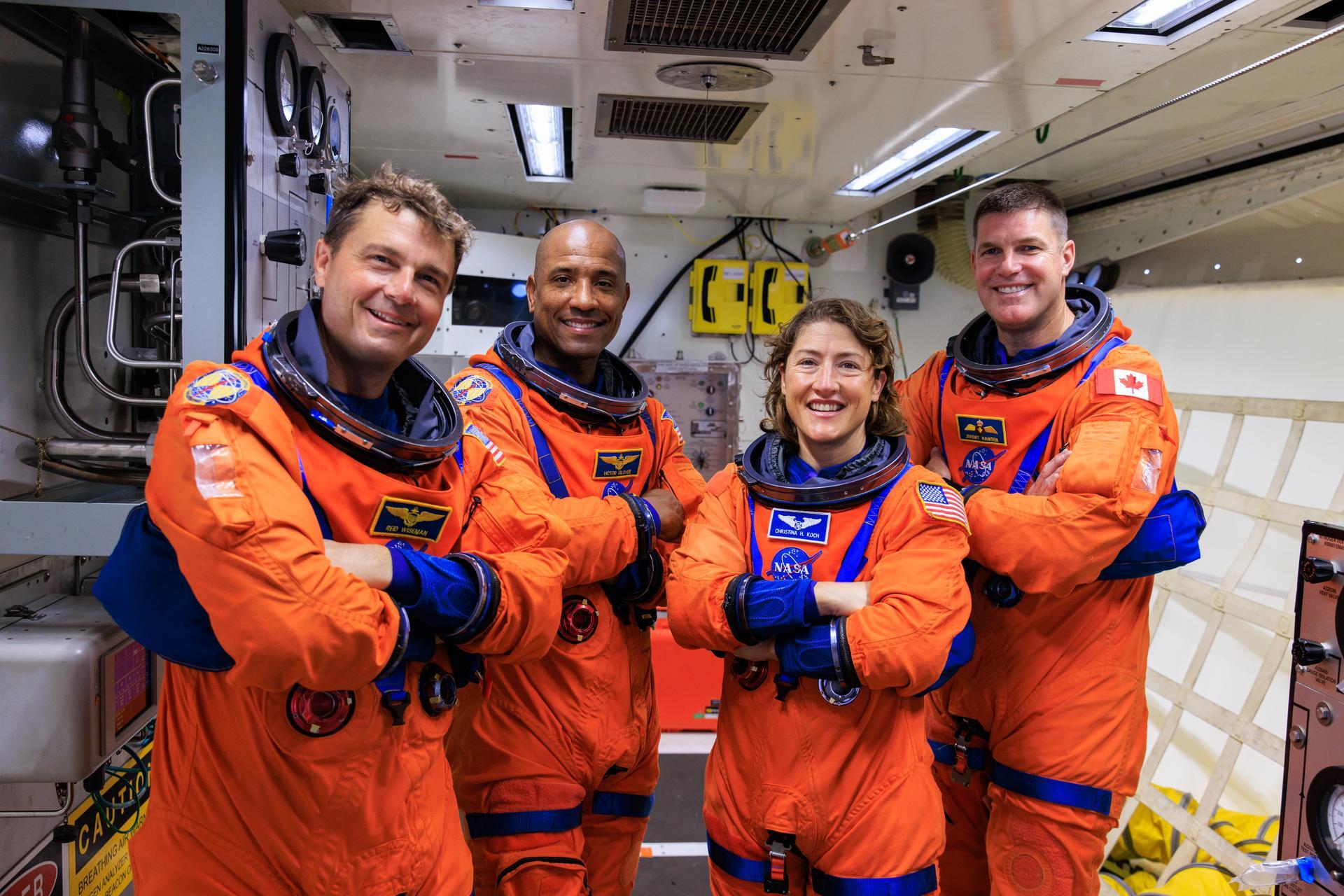
This month, the crew is beginning orbit operations training, including practicing operations in the Orion mission simulator at Johnson. They also are learning details about how to use cameras inside Orion to take photos of their activities inside the spacecraft, and document views of Earth and the Moon through the spacecraft’s four primary windows. Medical training will prepare the crew to handle potential medical situations that could arise during their mission. In the coming months, they also will delve deeper into training for the last leg of the mission, their return to Earth and recovery by a combined NASA and U.S. Navy team, They’ll prepare for both normal and emergency exits from their spacecraft in the ocean.
With Artemis missions, NASA is collaborating with commercial and international partners to explore the Moon for scientific discovery and technology advancement and establish the first long-term presence on the Moon. The Moon missions will serve as training for how to live and work on another world as NASA prepares for human exploration of Mars.
Quelle: NASA
----
Update: 25.10.2023
.
Artemis II Orion Crew and Service Modules Joined Together
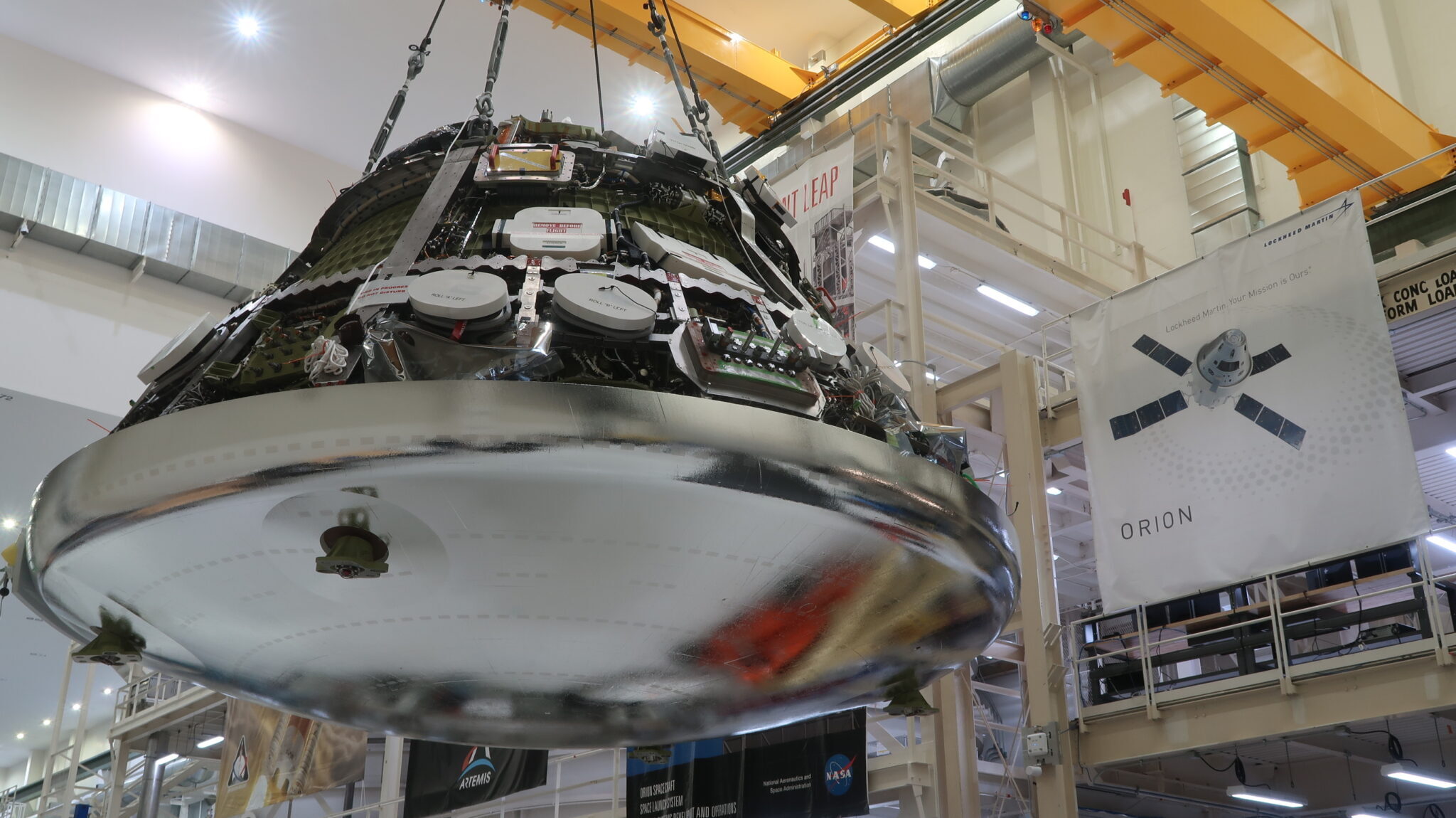
Intergration of the crew and service modules for the Artemis II Orion spacecraft was recently completed at NASA’s Kennedy Space Center in Florida. Photo credit: NASA
On Oct.19, the Orion crew and service modules for the Artemis IImission were joined together inside the Neil Armstrong Operations and Checkout Building at NASA’s Kennedy Space Center in Florida.
After successfully completing hardware installations and testing over the past several months, engineers connected the two major components of Orion that will fly NASA astronauts Reid Wiseman, Victor Glover, and Christina Koch, along with CSA (Canadian Space Agency) astronaut Jeremy Hansen on a mission around the Moon and bring them home safely.
Now that the crew and service modules are integrated, the team will power up the combined crew and service module for the first time. After power on test are complete, Orion will begin altitude chamber testing, which will put the spacecraft through conditions as close as possible to the environment it will experience in the vacuum of deep space.
Quelle: NASA
----
Update: 30.10.2023
.
Boeing ramps up final assembly to complete Artemis II SLS Core Stage by year end
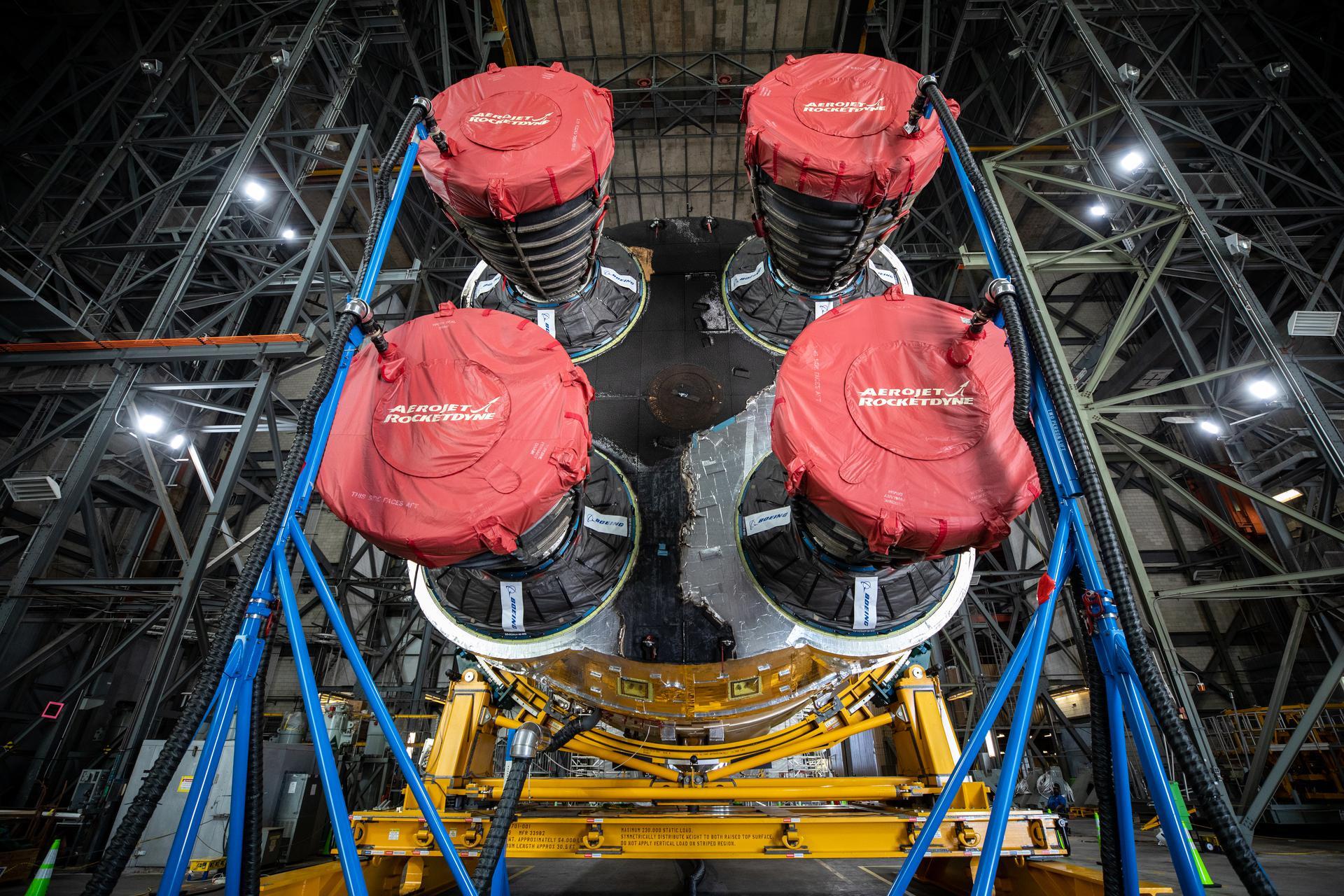
Following a cost-saving summer slowdown, NASA Space Launch System (SLS) Core Stage prime contractor Boeing is again working two shifts a day at the Michoud Assembly Facility (MAF) in New Orleans to complete final testing and checkout of the unit that will help send NASA astronauts back to the Moon on the Artemis II mission. Boeing plans to complete testing around the end of November, which would leave a few weeks of final thermal protection system (TPS) and configuration work to complete Core Stage-2 (CS-2) by the end of the year.
NASA approved reducing work activity on the stage down to a single work shift in the summer when issues with a supplier finishing liquid oxygen (LOX) feedline parts delayed their delivery until late September. Although Boeing may complete the stage by the new year, the space agency has not said when it will ship the stage to its Kennedy Space Center (KSC) launch site.
Final integrated testing started
Following initial bolting of the four RS-25 engines to the stage in mid/late September, the last of the four engines was “hard mated” on Oct. 6. Boeing started the final test and checkout campaign on the stage that same week, with the test readiness review (TRR) for final integrated function test (FIFT) completed on Oct. 2.
“We are roughly 16 percent complete; we’ve been through safe-to-mates [and] initial power-on,” Tim Burroughs, Boeing’s Integrated Product Team Lead for both Core Stage-2 and Core Stage-3, said in an interview with NSF at Michoud on Oct. 19. We’ve been through all the primary boxes powered on — CLSS (Cryogenic Level Sensing System), RINU (Redundant Inertial Navigation Unit), RGA (Rate Gyro Assemblies), etcetera. We just started yesterday (Oct. 18) our channelization activities on our DFI (development flight instrumentation), OFI (operational flight instrumentation) sensors, that’s fairly lengthy.”
Channelization testing will verify that every one of the hundreds or thousands of sensors on the stage respond to commands from its flight computers as specified. The first two stages have essentially the same package of sensors, Burroughs said: “Both have the same sensors, with the exception of the Green Run sensors, they’ve been removed, obviously.”
NASA decided several years ago to drop the requirement that the second core stage go through a Green Run test campaign at nearby Stennis Space Center in southern Mississippi. “Once we get through channelization, the next big test is the engine interface leaks, that’s when we pressurize the tanks and make sure all the engine interfaces obviously don’t leak,” Burrough said.
One of the lessons learned from final assembly during the first core stage build was to wait until after the leak checks of the stage-to-engine interfaces to install the final segments of the LOX feedlines, also called “downcomers.” During the interface leak checks for the first build, a lot more helium gas was consumed than necessary; helium is currently a scarce commodity, and Burroughs noted that this time “blank-off plates” are installed on the ends of the two partially installed downcomers.
“We have blank-off plates installed on segment fours,” he said. “Segment fives are sitting ready to [be installed] as soon as we get through that test case.” At the time of the interview, three segments remained to be installed on the two downcomers, two segment fives and a segment six. The latter segment can be installed before the leak checks, which attaches on the outside of the stage where the two feedlines exit the inside of the interank.
Following the stage-to-engine interface leak checks, Burroughs said that the FIFT would move on to testing of the stage’s battery units and functional testing of the LOX and liquid hydrogen (LH2) systems. The two propellant tanks will be pressurized again, and all the stage main propulsion system (MPS) valves and related hardware will be tested.
There still remains some thermal protection system (TPS) applications to complete, both within the stage’s interior and on its exterior; Burroughs said Boeing will do as much final spray-on foam insulation (SOFI), cork, and white “hypalon” paint work as they can during FIFT on a “non-interference basis.”
“We’re working that concurrently,” he said. “Test gets priority, obviously. We have a board over there that allows certain work to be done based on what we’re doing in test, but the plan is to get all the [bolted] flanges closed out [with SOFI], as well as all the hypalon here, in parallel with test.
“And then there’s a whole host of work that you have to do post FIFT.”
One of the most visible differences in the final integrated test campaign for this second and last core stage to be fully assembled at MAF is testing the stage’s hydraulics and thrust vector control (TVC) system. “The add-on here from Stennis is the TVC actuation, that’s the new test here at MAF. We did that at Green Run in the vertical.”
The stage will gimbal the four engines to verify the TVC systems and the hydraulic interfaces to four RS-25 engines.
A formal “break of configuration” review will be held at the end of FIFT, which will confirm that the vehicle systems behaved correctly, and all the required test data was collected with the hardware in its test configuration before disconnecting test equipment. “Right now, the forecast for break of configuration is around November 30, barring no findings in FIFT.” Burroughs said.
Access to some internal interfaces for testing has to be covered with foam for flight, and that can’t occur until after the test equipment is removed. “You’ve got to do TPS closeouts and different electrical mates, post FIFT, when you disconnect the test equipment and reinstall flight [equipment].” The stage flight computers are loaded with a special “fork” of the SLS flight software code for acceptance testing of systems during final assembly and one of the final steps before “break of configuration” will be to upload and install the flight computer application software (FCAS) onto the three computers.
Following completion of FIFT, there is approximately two to three weeks’ worth of final configuration of the stage, both for shipment to KSC and for flight. “That’s the whole rotation [sequence] that takes two to three weeks to get all that activity completed,” Burroughs said. With the stage in a horizontal orientation, it needs to be rotated to provide working access for the teams doing final “detailing” work on the exterior of the stage.
Boeing plans to complete Core Stage-2 by the end of the year; NASA is waiting until closer to completion of the stage to decide when to ship it from New Orleans to KSC for integration with the rest of the flight vehicle for the Artemis II crewed, lunar flyby mission.
Last horizontal final assembly planned
Core Stage-2 is the second and last unit that will be fully assembled at Michoud in a horizontal orientation. In the future, final assembly will be performed vertically in High Bay 2 of the Vehicle Assembly Building, where Boeing is currently laying the groundwork for eventual installation of platforms that will support work and/or storage of two core stages concurrently.
Final assembly of the first core stage was originally conceived to be partially vertical, partially horizontal; when the major joins of the different pieces of the stage were converted to a horizontal operation, a few assembly tasks were deferred to Stennis during the Green Run, when the stage was installed vertically in the B-2 Test Stand there. One of the last remaining production tasks was full attachment and securing of the four LH2 engine feedlines that run from the bottom of the stage’s LH2 tank to the hydrogen inlets for each of the RS-25 engines.
For this last horizontal build, which won’t go to Stennis, tooling and procedures were developed to fully secure the feedlines in that orientation at Michoud. Burroughs said that the feedline attachments went “exceptionally well.”
“We did a lot of pre-planning based on lessons learned on CS-1, installing access kits for the first time,” he noted. “So we built that tool up outside, we scanned it, we scanned the as-built configuration of the engine section, identified any issues we had well in advance of installing it, made some tweaks to the tool, and it went in extremely [well], actually took about five days to install it.”
“We had better than planned access, we were able mate those feedlines quite efficiently, actually.” The feedlines were attached shortly after the engine section was mated to the rest of the stage in mid-March, which required the stage to be rotated a couple of times.
“The kit goes in twice,” Burroughs said. “You go in and do two feedlines and the fill and drain line in one orientation and then you have to pull the kit, rotate, put it back in, and get the other two.”
That work had to be completed at the beginning of the sequence after the engine section was mated, because installation of platform kits inside the intertank, engine section, and boattail areas required the stage to be in the second orientation.
Final integrated testing of the stage is occurring about four years after the first build reached that milestone in the fall of 2019. “We’re essentially almost four years to the day we were at the same spot on CS-1 and as everyone knows we delivered [that in] early January [2020],” Burroughs noted.
“We’re about three weeks ahead [with this build from] where we were [with the first one], so we’re postured real well now to finish the vehicle by the end of the year. Mechanically, the stage is further along than CS-1 was [at this time], with the exception of the two feedline segments that we purposefully left off.”
“The systems tunnel is further along; we have to put the covers on, post FIFT,” he added. “Most of those are staged throughout the [final assembly] area around here.”
Aerodynamic fairings for the two LOX feedlines were seen in the area being prepared for installation; one had already seen its cork and white paint applied, the other was still getting its layer of cork. Almost all of the systems tunnel cover plates are covered with spray-on foam, with the exception of the elements on the end that get cork and white paint.
Most of those systems tunnel cover plates will be installed for shipment to KSC. “We intentionally leave four or five of them off for the shaped charges to [be installed in Florida at KSC]. We’ll put plastic [covers] there because don’t want them [taken] on and off, on and off. When we went to Stennis with CS-1 they were red, tooling covers for the environment, [they] did not need the foam for Green Run.”
In addition, two-piece engine fairings will be installed after FIFT, part of the requirement to rotate the vehicle to different orientations. Non-flight, engine mounted heatshield blankets will also be installed to seal the engine section so that the inside can be kept dry.
“We’ve got to maintain purge for shipping inside the engine section so that makes it air tight around the engines,” Burroughs noted. He also noted that Aerojet Rocketdyne, an L3Harris Technologies Company, will install their red covers over the nozzles for the barge trip to KSC.
The boattail will also look a little different at completion this time without the silver, foil tape that was applied for the Green Run hot-fire. Instead, the bottom of the stage will have a more flight-like appearance, mostly covered with white paint over the top of cork.
NASA approves of work slow down in the summer, delays completion to end of year
NASA approved a slow down of Boeing’s work to complete the stage in the middle of the year, due to delays in shipment of a couple of the LOX feedline segment from a supplier.
“Our last two segment five downcomers they did not have a DX rating at the supplier,” Burroughs explained. “That, coupled with other challenges with those feedlines, delayed the delivery of those.”
“So, Boeing purposely working with NASA scaled back the final assembly work scope on CS-2 to a single shift, looking for affordability options, if you will. Now that the feedlines came in, we ramped back up to dual-shift, all-hands-on-deck to finish the vehicle.”
NASA’s Inspector General recently published an Oct. 19 report with the first words on the delays caused by national security priorities at the parts supplier. The Department of Defense establishes the priority that government suppliers must work on U.S. national security projects.
“The DPAS (Defense Priorities and Allocations System) regulation establishes two priority levels, DX and DO,” the IG-24-003 report said. “A DX rating takes precedence over DO, is assigned to those programs of the highest national priority, and must be approved by the Secretary of Defense.”
“While not all NASA contracts are assigned a DPAS rating, some Artemis contracts have received the second level rating of DO,” the report added. “Despite having this rating, order fulfillment is delayed if a supplier receives a DX-rated order, as all work on NASA and other DO-rated contracts stops until the DX-rated contract needs are met.”
“The feedlines really caused us to take a step back, pause, and look at affordability, and not run really fast and hard for the last three or four months as we waited for those last two feedlines,” Burroughs said. “We knew of the feedline delays [in] roughly [the] July timeframe or June, we saw them sliding and then the DX rating caused further slip.”
“Once we got new dates from our suppliers, that’s when we made the adjustment and slowed down, if you will, to save money.”
Quelle: NSF
----
Update: 19.11.2023
.
Artemis II Astronauts View SLS Core Stage at Michoud
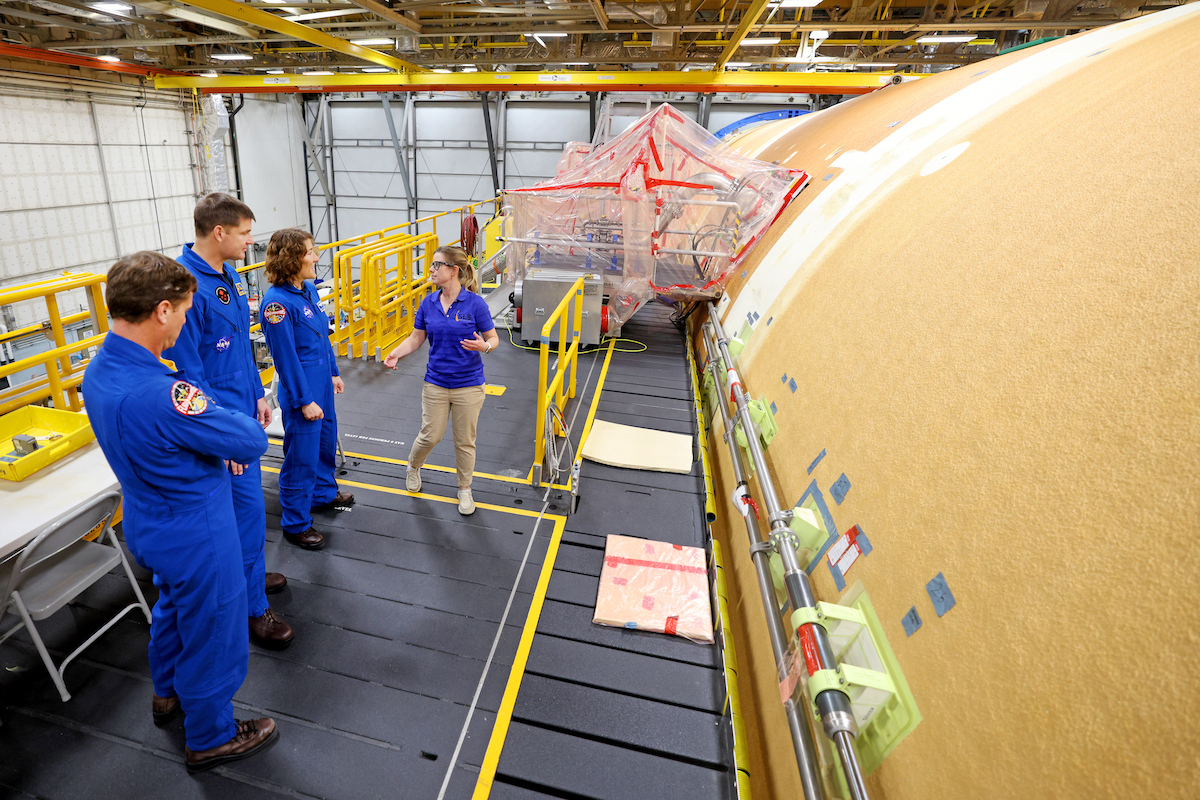
Artemis II NASA astronauts Reid Wiseman and Christina Koch of NASA, and CSA (Canadian Space Agency) astronaut Jeremy Hansen view the core stage for the SLS (Space Launch System) rocket at the agency’s Michoud Assembly Facility in New Orleans on Nov. 16. The three astronauts, along with NASA’s Victor Glover, will launch atop the rocket stage to venture around the Moon on Artemis II, the first crewed flight for Artemis.
The SLS core stage, towering at 212 feet, is the backbone of the Moon rocket and includes two massive propellant tanks that collectively hold 733,000 gallons of propellant to help power the stage’s four RS-25 engines. NASA, Boeing, the core stage lead contractor, along with Aerojet Rocketdyne, an L3Harris Technologies company and the RS-25 engines lead contractor, are in the midst of conducting final integrated testing on the fully assembled rocket stage. At launch and during ascent to space, the Artemis astronauts inside NASA’s Orion spacecraft will feel the power of the rocket’s four RS-25 engines producing more than 2 million pounds of thrust for a full eight minutes. The mega rocket’s twin solid rocket boosters, which flank either side of the core stage, will each add an additional 3.6 million pounds of thrust for two minutes.
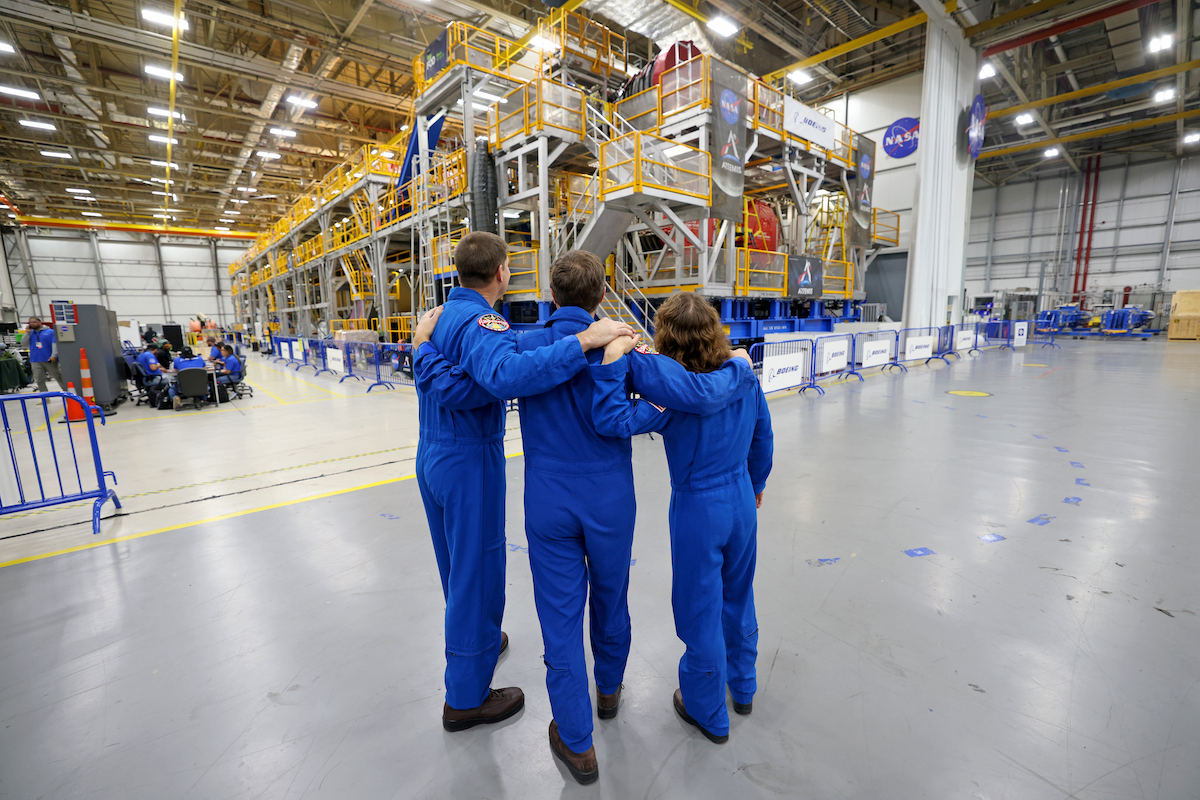
The astronauts’ visit to Michoud coincided with the first anniversary of the launch of Artemis I. The uncrewed flight test of SLS and Orion was the first in a series of increasingly complex missions for Artemis as the agency works to return humans to the lunar surface and develop a long-term presence there for discovery and exploration.
NASA is working to land the first woman and first person of color on the Moon under Artemis. SLS is part of NASA’s backbone for deep space exploration, along with the Orion spacecraft, advanced spacesuits and rovers, the Gateway in orbit around the Moon, and commercial human landing systems. SLS is the only rocket that can send Orion, astronauts, and supplies to the Moon in a single mission.
Quelle: NASA
----
Update: 30.11.2023
.
Artemis II Crew Signs NASA Moon Rocket Hardware at Marshall
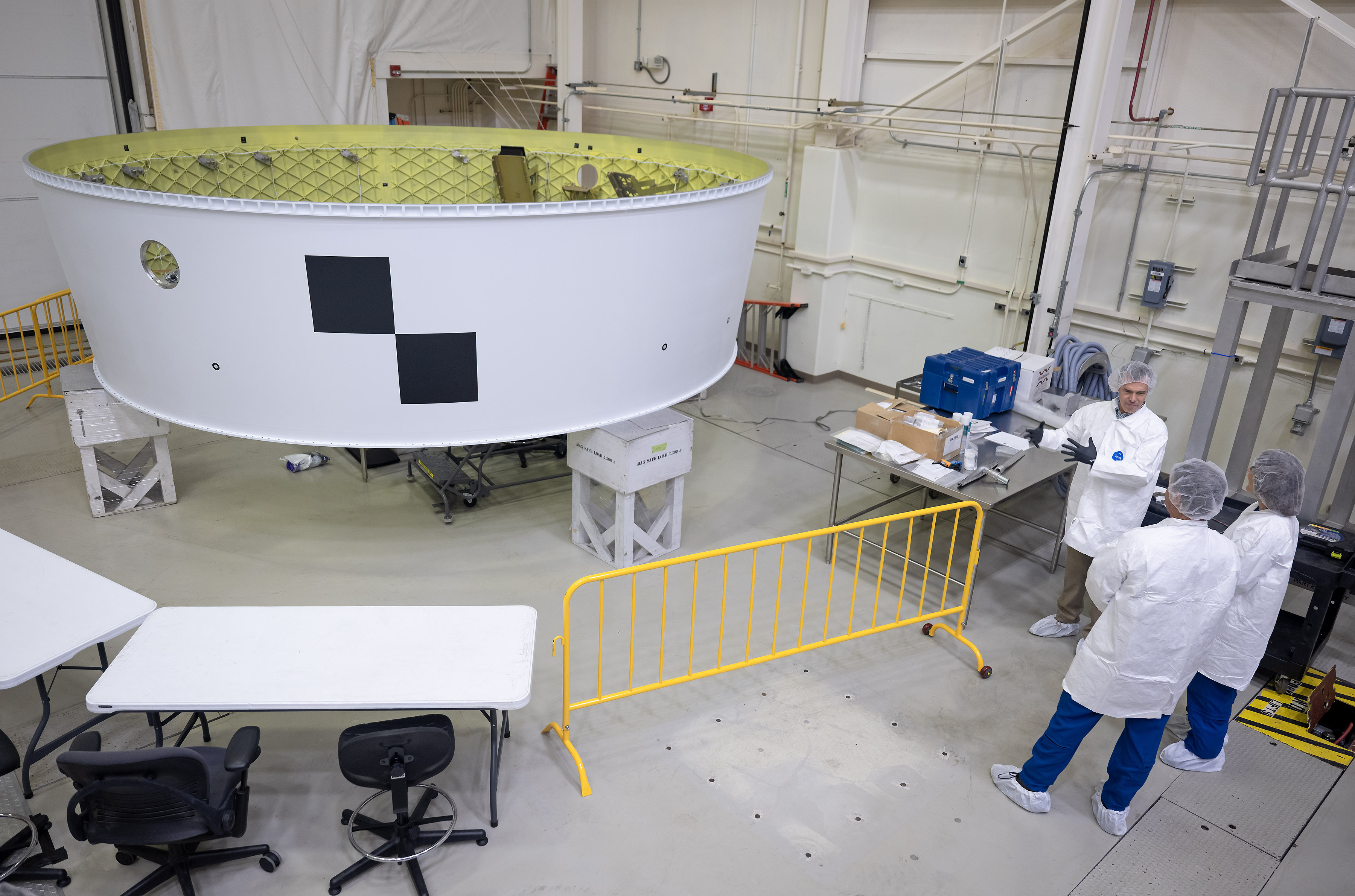
Artemis II NASA astronauts Victor Glover, Reid Wiseman, and Christina Koch of NASA, and CSA (Canadian Space Agency) astronaut Jeremy Hansen signed the Orion stage adapter for the SLS (Space Launch System) rocket at NASA’s Marshall Space Flight Center in Huntsville, Alabama, Nov. 27. The hardware is the topmost portion of the SLS rocket that they will launch atop during Artemis II when the four astronauts inside NASA’s Orion spacecraft will venture around the Moon.
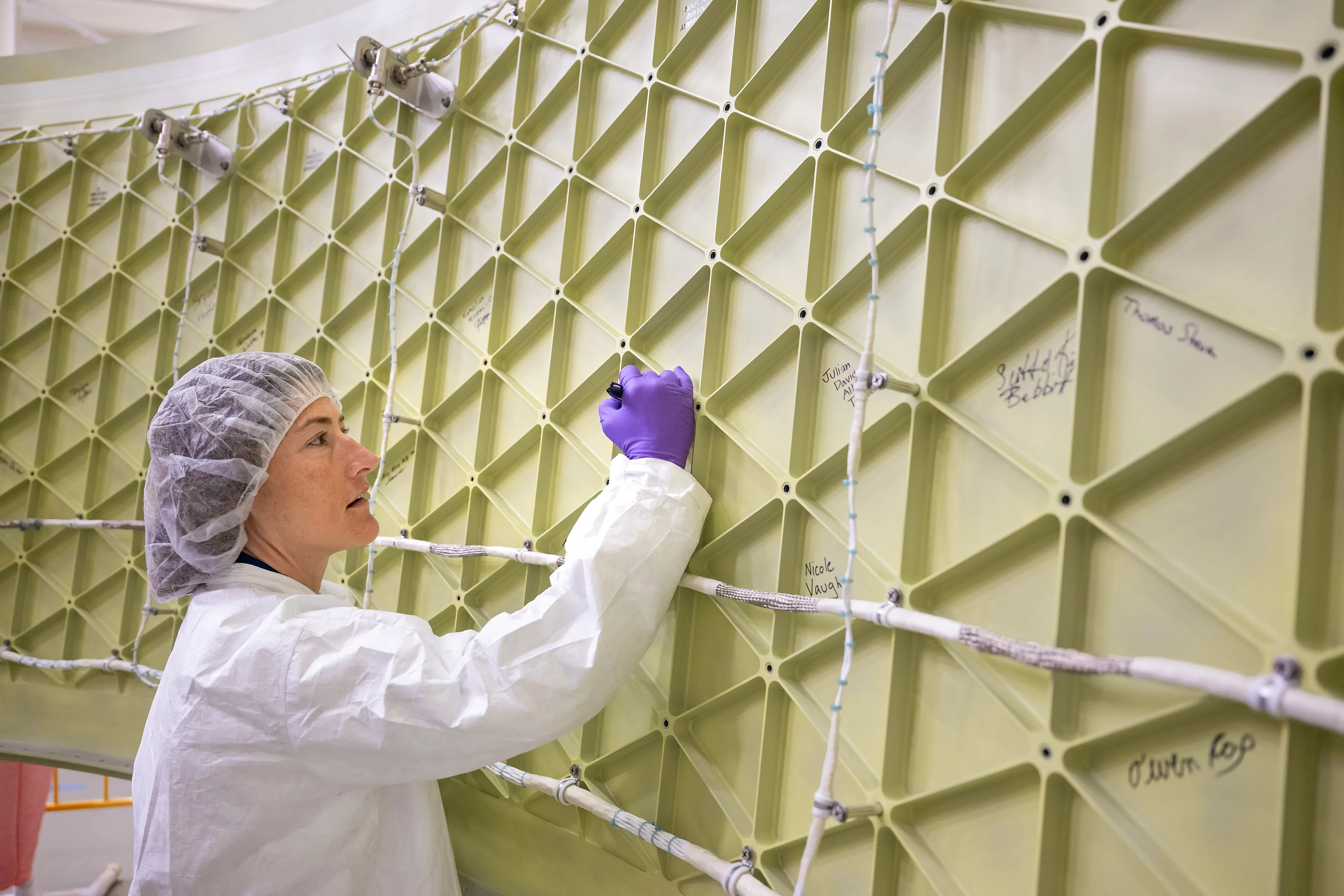
Artemis II astronauts Jeremy Hansen sign the SLS Orion stage adapter for the Artemis II mission during their visit to NASA’s Marshall Space Flight Center in Huntsville, Alabama, Nov. 27.
Image credits: NASA/Charles Beason
The Orion stage adapter is a small ring structure that connects NASA’s Orion spacecraft to the SLS rocket’s interim cryogenic propulsion stage and fully manufactured at Marshall. At five feet tall and weighing 1,800 pounds, the adapter is the smallest major element of the SLS rocket. During Artemis II, the adapter’s diaphragm will serve as a barrier to prevent gases created during launch from entering the spacecraft.
NASA is working to land the first woman and first person of color on the Moon under Artemis. SLS is part of NASA’s backbone for deep space exploration, along with the Orion spacecraft, advanced spacesuits and rovers, the Gateway in orbit around the Moon, and commercial human landing systems. SLS is the only rocket that can send Orion, astronauts, and supplies to the Moon in a single mission. Through Artemis, NASA will explore more of the lunar surface than ever before and prepare for the next giant leap: sending astronauts to Mars.
Quelle: NASA
----
Update: 9.12.2023
.
Artemis II Crew’s SLS Visit
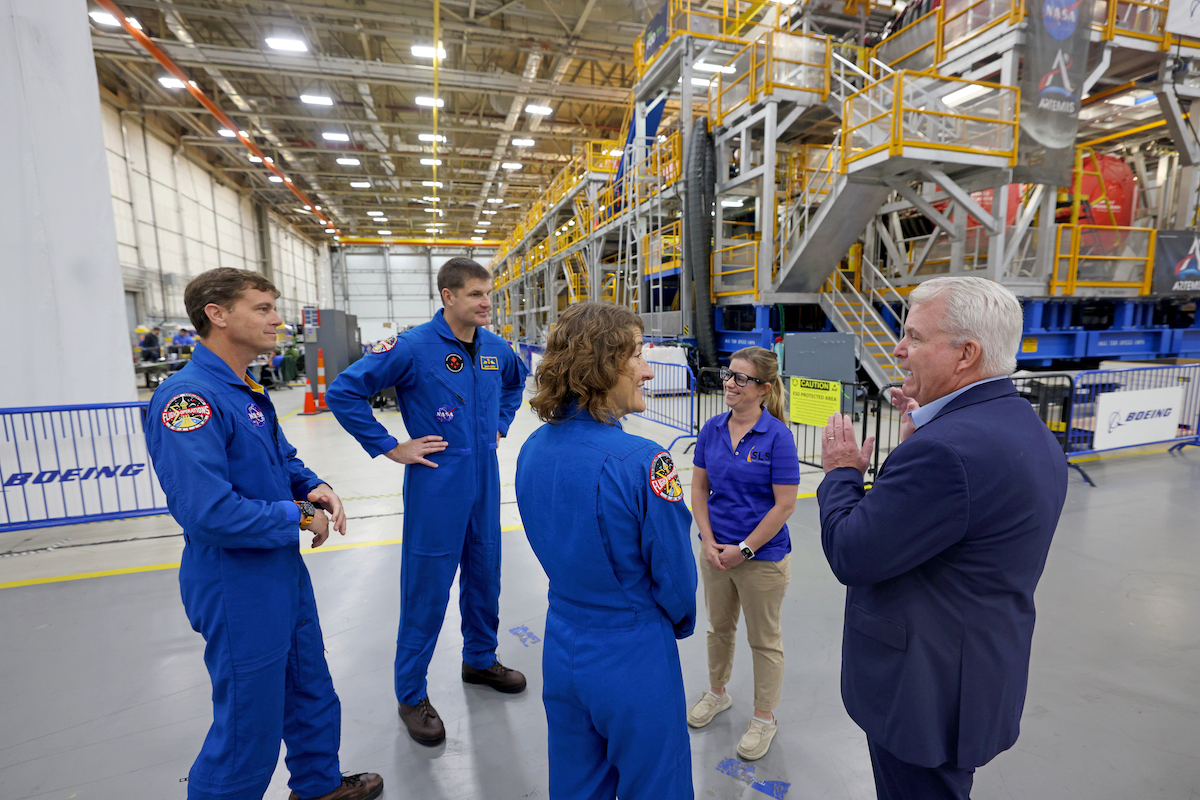
On Nov. 16, 2023, NASA astronauts Reid Wiseman (left) and Christina Koch (middle) of NASA and CSA (Canadian Space Agency) astronaut Jeremy Hansen (second from left) view the core stage for the Space Launch System (SLS) rocket at NASA’s Michoud Assembly Facility in New Orleans. The three astronauts, along with NASA’s Victor Glover, will launch atop the rocket stage to venture around the Moon on Artemis II, the first crewed flight for Artemis.
The astronauts’ visit to Michoud coincided with the first anniversary of the launch of Artemis I. The uncrewed flight test of SLS and Orion was the first in a series of increasingly complex missions for Artemis as the agency works to return humans to the lunar surface and develop a long-term presence there for discovery and exploration.
Quelle: NASA
----
Update: 13.12.2023
.
NASA Teams Prepare Moon Rocket-to-Spacecraft Connector for Assembly
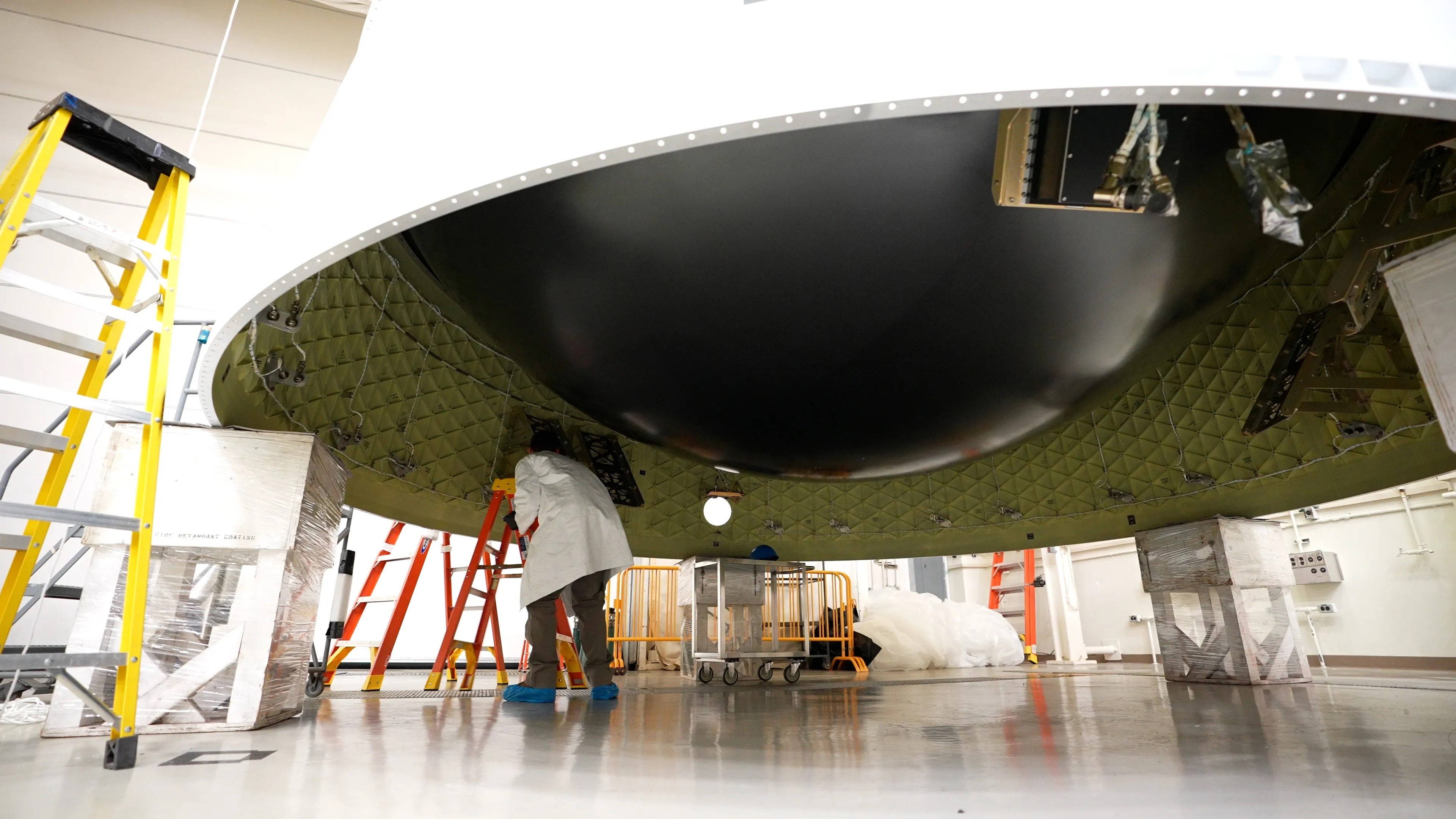
NASA/Sam Lott
The elements of the super-heavy lift SLS (Space Launch System) rocket for NASA’s Artemis II mission are undergoing final preparations before shipment to NASA’s Kennedy Space Center in Florida for stacking and pre-launch activities in 2024.
Teams at NASA’s Marshall Space Flight Center in Huntsville, Alabama, recently rotated the Orion stage adapter– a ring structure that connects NASA’s Orion spacecraft to the SLS rocket’s interim cryogenic propulsion stage (ICPS) – in preparation for the installation of its diaphragm. The installation Nov. 30 marks one of the final steps for the adapter before it is readied for shipment to Kennedy via NASA’s Super Guppy cargo aircraft.
“The diaphragm is a composite, dome-shaped structure that isolates the volume above the ICPS from that below Orion,” said Brent Gaddes, lead for the Orion stage adapter, in the Spacecraft/Payload Integration & Evolution Office for the SLS Program at Marshall. “It serves as a barrier between the two, preventing the highly flammable hydrogen gas that could escape the rocket’s propellant tanks from building up beneath the Orion spacecraft and its crew before and during launch.”
At five feet tall and weighing in at 1,800 pounds, the adapter is the smallest major element of the SLS rocket that will produce more than 8.8 million pounds of thrust to launch four Artemis astronauts inside Orion around the Moon. The adapter is fully manufactured by engineering teams at Marshall.
NASA is working to land the first woman and first person of color on the Moon under Artemis. SLS is part of NASA’s backbone for deep space exploration, along with Orion and the Gateway in orbit around the Moon, and commercial human landing systems. SLS is the only rocket that can send Orion, astronauts, and supplies to the Moon in a single launch.
Quelle: NASA
----
Update: 21.12.2023
.
Artemis II Crew Trains for Emergency Scenarios Ahead of Moon Mission
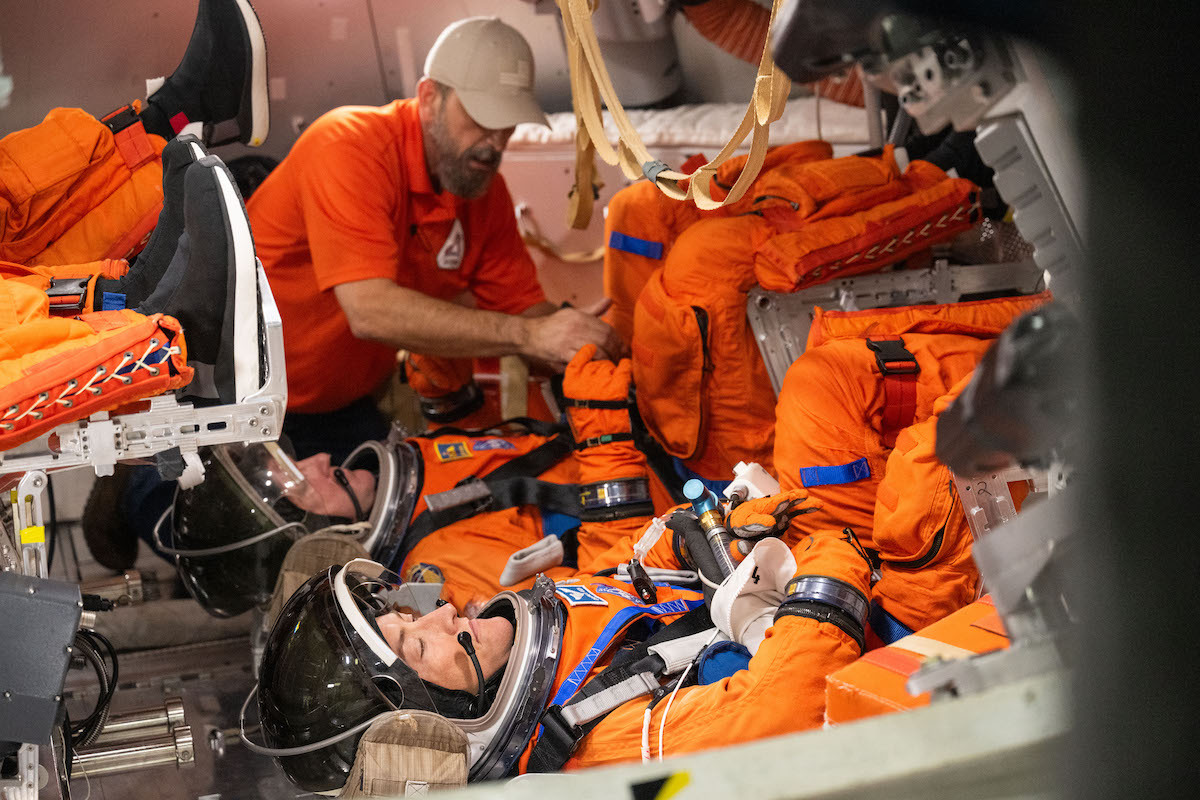
Credit: NASA/James Blair
The four Artemis II astronauts practiced procedures to exit the Orion spacecraft in an emergency during training at NASA’s Johnson Space Center in Houston on Dec. 15. NASA astronaut Christina Koch (foreground) and CSA (Canadian Space Agency) astronaut Jeremy Hansen were assisted by Bill Owens, Artemis II spacesuit technician. The training included exiting both the side and top hatches of the spacecraft to ensure the crew will be ready for potential emergency scenarios upon splashdown in the Pacific Ocean that would require them to leave the capsule before the recovery team arrives. The Artemis II mission will send the crew on an approximately 10-day flight test around the Moon. Under Artemis, NASA will return humans to the Moon for long-term exploration and scientific discovery.
Quelle: NASA
----
Update: 3.01.2024
.

